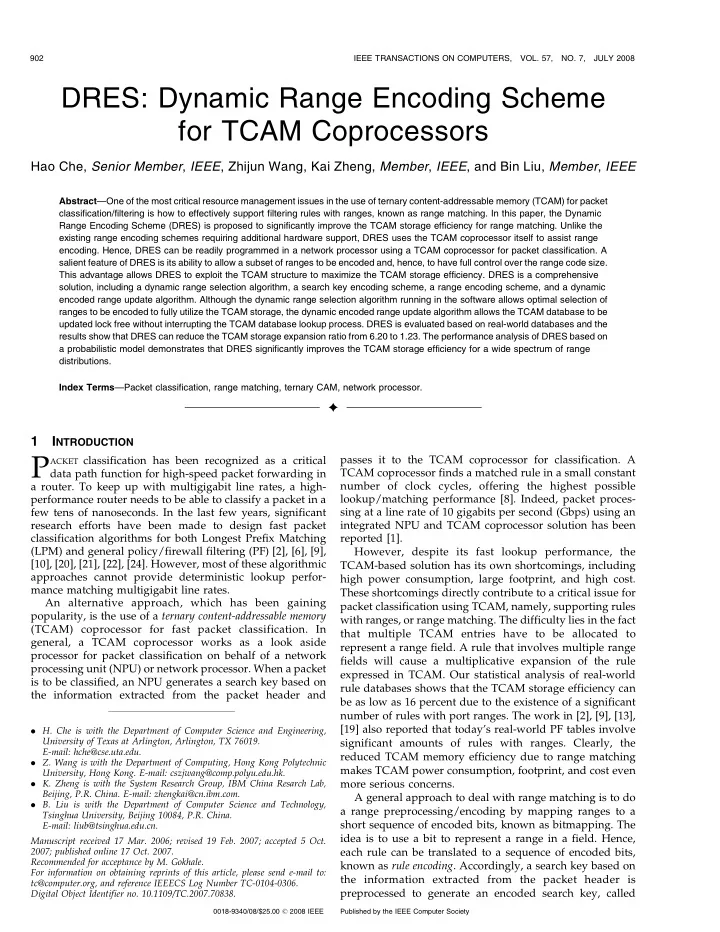

902 IEEE TRANSACTIONS ON COMPUTERS, VOL. 57, NO. 7, JULY 2008 DRES: Dynamic Range Encoding Scheme for TCAM Coprocessors Hao Che, Senior Member , IEEE , Zhijun Wang, Kai Zheng, Member , IEEE , and Bin Liu, Member , IEEE Abstract —One of the most critical resource management issues in the use of ternary content-addressable memory (TCAM) for packet classification/filtering is how to effectively support filtering rules with ranges, known as range matching. In this paper, the Dynamic Range Encoding Scheme (DRES) is proposed to significantly improve the TCAM storage efficiency for range matching. Unlike the existing range encoding schemes requiring additional hardware support, DRES uses the TCAM coprocessor itself to assist range encoding. Hence, DRES can be readily programmed in a network processor using a TCAM coprocessor for packet classification. A salient feature of DRES is its ability to allow a subset of ranges to be encoded and, hence, to have full control over the range code size. This advantage allows DRES to exploit the TCAM structure to maximize the TCAM storage efficiency. DRES is a comprehensive solution, including a dynamic range selection algorithm, a search key encoding scheme, a range encoding scheme, and a dynamic encoded range update algorithm. Although the dynamic range selection algorithm running in the software allows optimal selection of ranges to be encoded to fully utilize the TCAM storage, the dynamic encoded range update algorithm allows the TCAM database to be updated lock free without interrupting the TCAM database lookup process. DRES is evaluated based on real-world databases and the results show that DRES can reduce the TCAM storage expansion ratio from 6.20 to 1.23. The performance analysis of DRES based on a probabilistic model demonstrates that DRES significantly improves the TCAM storage efficiency for a wide spectrum of range distributions. Index Terms —Packet classification, range matching, ternary CAM, network processor. Ç 1 I NTRODUCTION P passes it to the TCAM coprocessor for classification. A ACKET classification has been recognized as a critical data path function for high-speed packet forwarding in TCAM coprocessor finds a matched rule in a small constant a router. To keep up with multigigabit line rates, a high- number of clock cycles, offering the highest possible performance router needs to be able to classify a packet in a lookup/matching performance [8]. Indeed, packet proces- few tens of nanoseconds. In the last few years, significant sing at a line rate of 10 gigabits per second (Gbps) using an research efforts have been made to design fast packet integrated NPU and TCAM coprocessor solution has been classification algorithms for both Longest Prefix Matching reported [1]. (LPM) and general policy/firewall filtering (PF) [2], [6], [9], However, despite its fast lookup performance, the [10], [20], [21], [22], [24]. However, most of these algorithmic TCAM-based solution has its own shortcomings, including approaches cannot provide deterministic lookup perfor- high power consumption, large footprint, and high cost. mance matching multigigabit line rates. These shortcomings directly contribute to a critical issue for An alternative approach, which has been gaining packet classification using TCAM, namely, supporting rules popularity, is the use of a ternary content-addressable memory with ranges, or range matching. The difficulty lies in the fact (TCAM) coprocessor for fast packet classification. In that multiple TCAM entries have to be allocated to general, a TCAM coprocessor works as a look aside represent a range field. A rule that involves multiple range processor for packet classification on behalf of a network fields will cause a multiplicative expansion of the rule processing unit (NPU) or network processor. When a packet expressed in TCAM. Our statistical analysis of real-world is to be classified, an NPU generates a search key based on rule databases shows that the TCAM storage efficiency can the information extracted from the packet header and be as low as 16 percent due to the existence of a significant number of rules with port ranges. The work in [2], [9], [13], [19] also reported that today’s real-world PF tables involve . H. Che is with the Department of Computer Science and Engineering, University of Texas at Arlington, Arlington, TX 76019. significant amounts of rules with ranges. Clearly, the E-mail: hche@cse.uta.edu. reduced TCAM memory efficiency due to range matching . Z. Wang is with the Department of Computing, Hong Kong Polytechnic makes TCAM power consumption, footprint, and cost even University, Hong Kong. E-mail: cszjwang@comp.polyu.edu.hk. . K. Zheng is with the System Research Group, IBM China Resarch Lab, more serious concerns. Beijing, P.R. China. E-mail: zhengkai@cn.ibm.com. A general approach to deal with range matching is to do . B. Liu is with the Department of Computer Science and Technology, a range preprocessing/encoding by mapping ranges to a Tsinghua University, Beijing 10084, P.R. China. short sequence of encoded bits, known as bitmapping. The E-mail: liub@tsinghua.edu.cn. idea is to use a bit to represent a range in a field. Hence, Manuscript received 17 Mar. 2006; revised 19 Feb. 2007; accepted 5 Oct. 2007; published online 17 Oct. 2007. each rule can be translated to a sequence of encoded bits, Recommended for acceptance by M. Gokhale. known as rule encoding . Accordingly, a search key based on For information on obtaining reprints of this article, please send e-mail to: the information extracted from the packet header is tc@computer.org, and reference IEEECS Log Number TC-0104-0306. preprocessed to generate an encoded search key, called Digital Object Identifier no. 10.1109/TC.2007.70838. 0018-9340/08/$25.00 � 2008 IEEE Published by the IEEE Computer Society
Recommend
More recommend